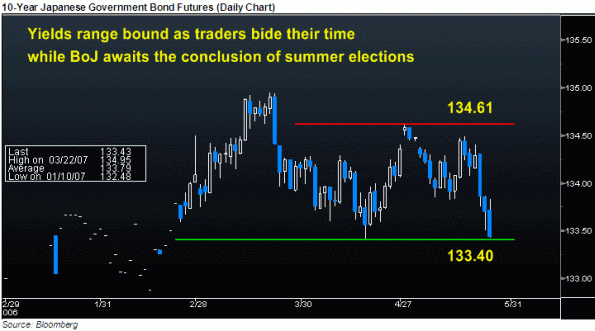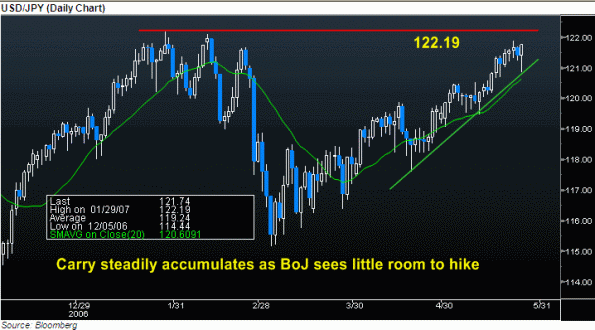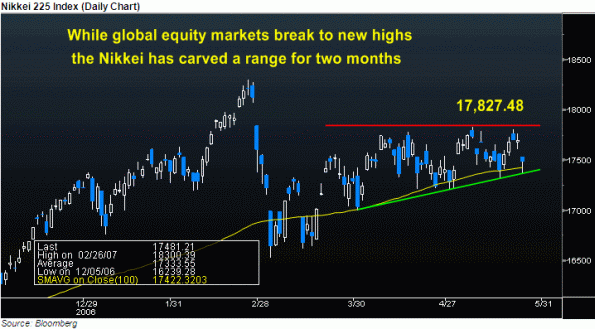| Will Improved Japanese Consumption Turn the Carry Trade? |
| By David Rodriguez |
Published
05/25/2007
|
Currency
|
Unrated
|
|
|
|
Will Improved Japanese Consumption Turn the Carry Trade?
Overall H’hold Spending (YoY) (APR) (23:30 GMT)
Expected: 0.2%
Previous: 0.1%
Retail Trade (MoM) (APR) (23:50 GMT)
Expected: 0.3%
Previous: -1.3%
How Will the Markets React?
Come Monday, half of the Western world and two of the three main FX hubs will be closed in observation of holidays. The US capital markets will extend the weekend with the Memorial Day holiday while German, British and Swiss financial institutions will be closed for Whit Monday. This means that the Far East – led by Japan – will be responsible for price action for a full 36 hours. In the opening hours of the week (which is typically a calm period to begin with), the Japanese docket will print its first indicator – a gauge of corporate service prices for the year through April. According to the consensus among economists, the report is expected to be largely uneventful with a 0.6 percent pace that matched that of the previous month. Regardless, the indicator does have some level of risk built into it since it will add another piece to the inflation puzzle. Anything resembling a near consensus print will be largely overlooked. Even a substantial surprise to the upside may see price action left untouched because of its low stature on the BoJ’s totem pole. A jump in service prices would hardly cue a return to inflation for the overall economy; and even if it did, the summer elections would keep things under wraps. On the other hand, Tuesday morning in Tokyo could mark the beginning of an active European and US session for the Japanese yen with readings on employment and consumer spending populating the calendar. Starting at 23:30 GMT, indicators measuring the unemployment rate and household spending for April will kick things off. The jobless read is expected to hold at 4.0 percent, supporting consumer sentiment. However, spending is the only gauge of sentiment that traders are concerned with. Consumer spending has been the disconnect between high corporate revenues and inflation. The overall household spending report is expected to pick up its annual pace modestly to 0.2 percent through April. This may be supported by a positive 0.3 percent print in retail sales.
Bonds – 10-Year Japanese Government Bond Futures
Japanese government bonds have been wandering the last two months as aimlessly as the benchmark Nikkei equities index. Recently, yields were pitched in a rather steep rally (prices declined) with only the fundamental aid of a modest improvement in the National CPI numbers. However, with JGB futures staring down 133.40 support from the mid-April spike, it may take more than a weak Corporate Service Price number to keep the move intact. In all probability, with global volatility soft due to various holidays, local traders will likely shy away from pushing yields higher – that is until the top-tier data hits the wires Monday evening in the western world (or Tuesday morning in Japan). Weak spending has kept the Japanese economy teetering on the edge of deflation and the BoJ in a holding pattern.

FX – USD/JPY
The ascent of USD/JPY has appeared unstoppable, as the pair has held with a thin channel since early March. However, USD/JPY has taken to range trading between 121.00 – 121.85 as resistance at 122.00 proves too powerful for the time being. While the Japanese yen looks ready to continue softening before making stronger tests of 122.00, the release of Overall Household Spending and Retail Trade could grant the currency a brief reprieve. Both figures are anticipated to edge higher in the month of April, in line with the pick up in consumption in the first quarter GDP report and raising the prospects of rate normalization by the Bank of Japan. While improvements in consumer spending were noted by the central bank as being necessary for additional rate hikes, a return to positive inflation was an even greater factor. With CPI still signaling deflation, there is little possibility for a 25 basis point move higher in the near term, even if the upcoming Japanese data shows gains in spending. As a result, USDJPY may only be able to make it as low as 121.00 amidst a bout of yen strength before returning to range trading, as more concrete data will be needed in order to seriously consider the possibility of BOJ policy action.

Equities – Nikkei 225 Index
Japanese stocks fell the most a month after US home sales unexpectedly surged on Thursday, damping speculation the Federal Reserve will cut interest rates in the region's biggest export market and leading the Nikkei 225 Stock Average to fall 1.2 percent to 17,481.21. Toyota, which receives about 60 percent of its operating profit from the US, fell 1.5 percent to 7,280 yen, the sharpest drop since May 10. Meanwhile, Canon Inc., the world's second-largest maker of digital cameras, slid 2 percent to 6,980 yen as the US serves as the company’s second largest market. However, a rebound in US equities on Friday could lead to a similar turnaround back above 17,500.00 for the Nikkei 225 when it opens this week. Economic data due out around the equity market opening could further any gains, as Overall Household Spending and Retail Trade are both anticipated to improve, boding well for the services and retail sector. However, if the data stretches far higher than expectations, the Nikkei 225 Index could turn a bit lower to below a supporting trendline near 17,420.00 as traders amidst worries that rising consumption could allow the Bank of Japan to consider raising rates.

John Kicklighter is a Currency Strategist at FXCM.
|